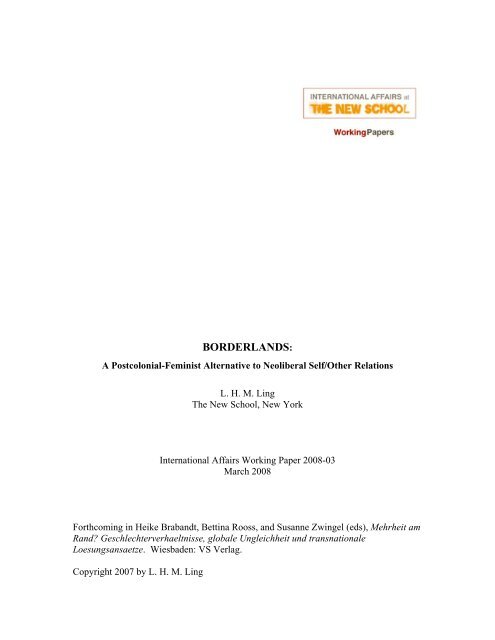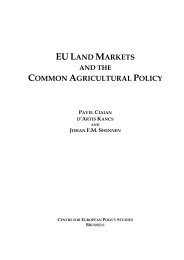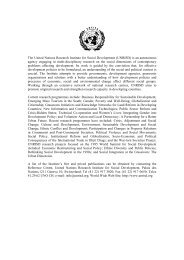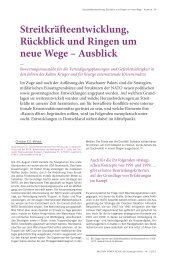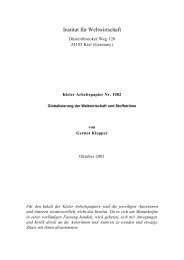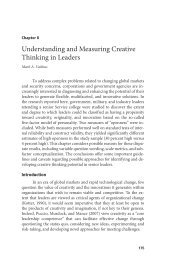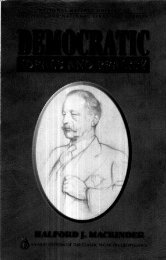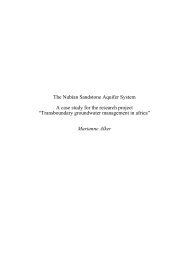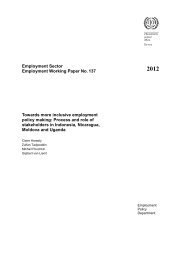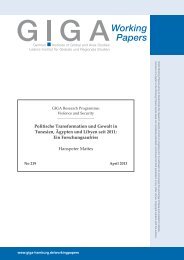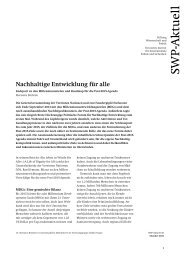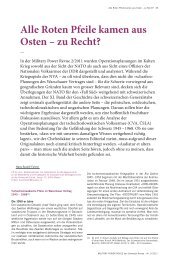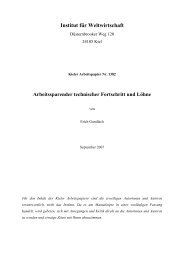A Postcolonial-Feminist Alternative to Neoliberal Self/Other Relations
A Postcolonial-Feminist Alternative to Neoliberal Self/Other Relations
A Postcolonial-Feminist Alternative to Neoliberal Self/Other Relations
You also want an ePaper? Increase the reach of your titles
YUMPU automatically turns print PDFs into web optimized ePapers that Google loves.
BORDERLANDS:<br />
A <strong>Postcolonial</strong>-<strong>Feminist</strong> <strong>Alternative</strong> <strong>to</strong> <strong>Neoliberal</strong> <strong>Self</strong>/<strong>Other</strong> <strong>Relations</strong><br />
L. H. M. Ling<br />
The New School, New York<br />
International Affairs Working Paper 2008-03<br />
March 2008<br />
Forthcoming in Heike Brabandt, Bettina Rooss, and Susanne Zwingel (eds), Mehrheit am<br />
Rand? Geschlechterverhaeltnisse, globale Ungleichheit und transnationale<br />
Loesungsansaetze. Wiesbaden: VS Verlag.<br />
Copyright 2007 by L. H. M. Ling
BORDERLANDS:<br />
A <strong>Postcolonial</strong>-<strong>Feminist</strong> <strong>Alternative</strong> <strong>to</strong> <strong>Neoliberal</strong> <strong>Self</strong>/<strong>Other</strong> <strong>Relations</strong><br />
L. H. M. Ling<br />
Graduate Program in International Affairs<br />
The New School<br />
lingl@newschool.edu<br />
www.gpia.info<br />
International Affairs Working Paper 2008-03<br />
March 2008<br />
ABSTRACT<br />
The neoliberal ‘good life’ demands one, unequivocal condition: convert or be<br />
disciplined. Conversion requires wholesale integration of the neoliberal <strong>Self</strong>’s<br />
policies, practices, and institutions at all sites of public policy-making for the<br />
<strong>Other</strong>, regardless of local his<strong>to</strong>ries, cultures, or desires. Discipline comes through<br />
economic, political, and sometimes military ‘conditionalities’ from the <strong>Self</strong> <strong>to</strong> the<br />
‘non-compliant’ <strong>Other</strong>. That both conversion and discipline mean a kind of<br />
annihilation for the <strong>Other</strong> is, for the neoliberal <strong>Self</strong>, a necessary risk. This<br />
includes the rise of rival camps of hypermasculinity that lead, invariably, <strong>to</strong><br />
perpetual cycles of competition and conflict. A ‘borderlands’ approach offers an<br />
alternative. Similar <strong>to</strong> ‘traveling’ theory from feminists of color, this notion of<br />
‘borderlands’ also draws from pre-colonial experiences such as the ancient Silk<br />
Roads where peoples, societies, languages, religions, and ways of life mixed,<br />
merged, and moved. ‘Borderlands’, in short, exemplifies a multiple worlds<br />
on<strong>to</strong>logy <strong>to</strong> world politics. Three cases illustrate the pitfalls of neoliberal<br />
<strong>Self</strong>/<strong>Other</strong> relations and why we need <strong>to</strong> move <strong>to</strong> the ‘borderlands’: (1) the Asian<br />
financial crisis (1997-1998), (2) US corporate corruption (2001-2002), and (3) the<br />
9/11 Commission Report (2004).
BORDERLANDS:<br />
A <strong>Postcolonial</strong>-<strong>Feminist</strong> <strong>Alternative</strong> <strong>to</strong> <strong>Neoliberal</strong> <strong>Self</strong>/<strong>Other</strong> <strong>Relations</strong><br />
L.H.M. Ling<br />
The New School<br />
INTRODUCTION 1<br />
‘Welcome <strong>to</strong> the Coke side of life’. 2 This slogan from one of corporate<br />
capitalism’s most famous icons encapsulates neoliberal globalization’s promise as well as<br />
its threat. That is, prosperity, equality, and happiness can be attained by all but on one,<br />
unequivocal condition: convert <strong>to</strong> the US-led, neoliberal world-order or be disciplined.<br />
Conversion entails wholesale integration of neoliberal policies, practices, and institutions<br />
at all sites of public policy-making, regardless of local his<strong>to</strong>ries, cultures, or desires.<br />
Discipline comes through economic, political, and sometimes military ‘reform’ by the<br />
neoliberal ‘<strong>Self</strong>’ on<strong>to</strong> recalcitrant ‘<strong>Other</strong>s’. 3 And if both mean a kind of annihilation for<br />
the <strong>Other</strong>, neoliberals reason, so be it. The world, after all, needs <strong>to</strong> be democratized and<br />
liberalized <strong>to</strong> enjoy an enduring peace. 4<br />
1<br />
An earlier version of this paper was delivered as a keynote address <strong>to</strong> the Gender and Politics<br />
Section of the German Political Science Association, Muenster, 25-29 September 2006.<br />
2<br />
This is the Coca Cola Company’s advertising slogan for 2006 (http://www.2collectcola.<br />
com/page/ACC/slogan).<br />
3<br />
The terms ‘<strong>Self</strong>’ and ‘<strong>Other</strong>’ refer <strong>to</strong> a social dicho<strong>to</strong>my. It posits two, supposedly opposite<br />
identities differentiated by colonial constructions of race, gender/sexuality, class, and nationality.<br />
The ‘<strong>Self</strong>’ represents a configuration of whiteness-Christianity-’the West’ and possesses<br />
rationality, wealth, and power. The ‘<strong>Other</strong>’ mires in negation due <strong>to</strong> its brownness, blackness or<br />
yellowness shackled by superstitions or fundamentalisms coming from ‘the Orient’, ‘the New<br />
World’, or ‘the heart of darkness’ and exhibits irrationality, poverty, and powerlessness (cf. Said<br />
1979). Updated for contemporary ‘development’, ‘<strong>Self</strong>’ and ‘<strong>Other</strong>’ have come <strong>to</strong> stand in for<br />
‘developed’ and ‘underdeveloped/developing’ economies, respectively, in liberal discourse and<br />
‘center’ and ‘periphery’, respectively, for world systems theory. Given their constructed nature,<br />
‘<strong>Self</strong>’ and ‘<strong>Other</strong>’ are treated here as contingent and provisional, although I write them without<br />
scare quotes in the rest of the text for simplicity’s sake.<br />
4<br />
See, for example, ‘democratic peace’ theory (cf. Gartzke 2007).<br />
1
This neoliberal imperium sets up two, interrelated asymmetries:(1) a geospatialeconomic<br />
‘West’ 5 at the center of world politics and everyone else on the periphery (cf.<br />
Bull 1966, Wallerstein 1974, 1980, 1989), and (2) a cultural-institutional one that<br />
valorizes hypermasculine whiteness over all other ways of being and relating <strong>to</strong> others (cf.<br />
Hall/Ling forthcoming). 6 Both are underwritten by colonial-capitalist practices of race,<br />
gender, sexuality, class, and nationality. Put differently, neoliberal globalization is not<br />
simply an abstract system of ‘empire’ as suggested by some (Hardt and Negri 2000).<br />
Rather, it stems from and aims <strong>to</strong> consolidate an imperium of social relations that assigns<br />
a minority of the world’s population the privilege of managing and consuming the<br />
capitalist world-order and the majority <strong>to</strong> supplying, laboring, and sacrificing for it.<br />
Not surprisingly, rival camps of hypermasculinity arise in response.<br />
Hypermasculine competition becomes a strategy for many <strong>Other</strong>s precisely because they<br />
are tired of being peripheralized and moreso, feminized and/or infantilized by neoliberal<br />
globalization. But efforts <strong>to</strong> re-center themselves often rely on neoliberal methods of<br />
property accumulation and <strong>Self</strong>/<strong>Other</strong> relations, thereby reproducing similar relations of<br />
exploitation, oppression, and infantilization of the <strong>Other</strong>’s <strong>Other</strong>s: e.g., women, workers,<br />
peasants, minorities, and so on. Violence escalates, then, by becoming normalized,<br />
damning our world <strong>to</strong> eternal battles between contending camps of hypermasculinity.<br />
This chapter proposes a postcolonial-feminist alternative: ‘borderlands’. Not<br />
only does it disrupt neoliberalism’s fixed binaries along structural lines (conversion vs<br />
discipline, center vs periphery, West vs Rest), but it also addresses the neoliberal<br />
imperium’s unacknowledged yet explicit designation of <strong>Self</strong>/<strong>Other</strong> relations along<br />
colonial designations of race, gender, sexuality, class, and nationality. To demonstrate, I<br />
refer <strong>to</strong> three recent events: (1) Asia’s financial crisis (1997-1998), (2) US corporate<br />
corruption scandals like Enron (2001-2002), and (3) The 9/11 Commission Report (2004),<br />
5 I place this geocultural location in scare quotes <strong>to</strong> signify its constructed and contingent nature.<br />
Indeed, so naturalized are these categories that we fail <strong>to</strong> interrogate how they came <strong>to</strong> be (cf.<br />
Halperin 2006).<br />
6 Nandy (1988) first coined the term ‘hypermasculinity’ <strong>to</strong> refer <strong>to</strong> colonial England’s underlying<br />
gender ideology <strong>to</strong> justify its ‘civilizing mission’ overseas. I draw on this term <strong>to</strong> indicate a<br />
slightly different condition: that is, a reactionary dis<strong>to</strong>rtion of traditional or ‘hegemonic<br />
masculinity’ (Connell 1995) <strong>to</strong> counter perceived attacks by other, especially ‘foreign’, sources of<br />
masculinity. In so doing, hypermasculinity itself becomes a source and means of threatening<br />
oneself as well as others.<br />
2
hereafter The Report, on the attacks on the World Trade Center, the Pentagon, and the<br />
White House on 11 September 2001. I have discussed these cases elsewhere and draw on<br />
them here (Ling 2002, 2005; Agathangelou and Ling 2005). Together, these demonstrate<br />
the hypermasculine whiteness behind neoliberal globalization.<br />
NEOLIBERAL GLOBALIZATION:<br />
Hypermasculine Whiteness in Action<br />
That centers and peripheries divide the international political economy is noncontroversial<br />
(cf. Little and Smith 2006). Less well-articulated is how these structures of<br />
asymmetry relate <strong>to</strong> colonial designations of race, gender, sexuality, class, and nationality.<br />
Given Western colonialism’s dominance for the past five centuries, the West naturalizes<br />
itself <strong>to</strong> be the center of world politics, as demonstrated by developmentalism’s<br />
longstanding maxim that the ‘underdeveloped’/’developing’ Third World should emulate<br />
the ‘developed’ First World in order <strong>to</strong> ‘catch up’ (cf. Fukuyama 1989). Richard Higgott<br />
(1998) made the case more explicitly when he cautioned the ‘white’ states of North<br />
America and Western Europe against a ‘politics of resentment’ from the ‘non-white’<br />
states of East and Southeast Asia during the Asian financial crisis.<br />
Here, gender plays in high relief. In claiming center status, colonial patriarchy<br />
assumes traits such as power, au<strong>to</strong>nomy, and security <strong>to</strong> be masculine. Contrastingly,<br />
colonial patriarchy feminizes those in the periphery as exiled, outsiders-looking-in,<br />
invariably wrought with emotion, contingency, and multiplicity (cf. Spurr 1993).<br />
Moreover, as Ashis Nandy (1988) has shown, the colonizer’s masculinity turns in<strong>to</strong> a<br />
hyper version <strong>to</strong> justify the ‘civilizing mission’ overseas.<br />
A zero-sum logic emerges: the <strong>Other</strong> must convert <strong>to</strong> the Christian, white,<br />
capitalist <strong>Self</strong> or be disciplined. From the 16 th -early 20 th centuries, this meant submission<br />
<strong>to</strong> ‘gunboat diplomacy’ or outright colonization (cf. Rodney 1973). <strong>Neoliberal</strong><br />
globalization updates this logic: the <strong>Other</strong> must convert <strong>to</strong> ‘free-market’ policies or be<br />
disciplined by ‘conditionalities’ from neoliberal institutions like the International<br />
Monetary Fund (IMF) or ‘regime change’ from the US hegemon (cf. Escobar 1996).<br />
3
Crises in the international political economy expose such hypermasculine<br />
whiteness most explicitly.<br />
Asia’s Financial Crisis (1997-1998)<br />
At the end of the 20 th -century, Asia’s ‘miracle’ economies seemed on the verge of<br />
collapse. A run on loans resulted with the IMF ‘rescuing’ Thailand with $17 billion,<br />
Indonesia with almost $40 billion, and South Korea with $57 billion (Pollack 1997). A<br />
thirty-year dicta<strong>to</strong>rship fell in Indonesia, riots and strikes erupted from Northeast <strong>to</strong><br />
Southeast Asia. The region seemed mired in chaos economically and politically.<br />
<strong>Neoliberal</strong> elites in the West crowed. There is only one economic model for the<br />
world <strong>to</strong> follow, in<strong>to</strong>ned then Chairman of the US Federal Reserve, Alan Greenspan, <strong>to</strong><br />
the Senate Foreign <strong>Relations</strong> Committee in February 1998, and that is ‘the Western form<br />
of free-market capitalism’ (Sanger 1998: 1). The neoliberal, mainstream media<br />
denounced the Asian financial crisis for its ‘complacency, cronyism, and corruption’<br />
(Singh and Weisse 1999: 204) aided by a ‘culture of deceit’ (Gibney 1998), among other<br />
fac<strong>to</strong>rs. Edi<strong>to</strong>rialist Thomas Friedman of the New York Times claimed that Asian<br />
societies lacked the ‘software’ (i.e., regula<strong>to</strong>ry agencies, banking controls, transparency,<br />
bureaucratic professionalism, civil society) <strong>to</strong> match the ‘hardware’ (i.e., relatively free<br />
markets, free trade, open capital flows) that advanced industrialization required (quoted<br />
in Rao 1998: 1411). Another observer proselytized that Asians needed <strong>to</strong> strengthen<br />
certain [read Western, masculine] values such as ‘directness’ and ‘transparency’ <strong>to</strong><br />
counter their [read Oriental, feminine] tendencies <strong>to</strong>ward ‘circumspection’ and ‘secrecy’<br />
(Rao 1998: 1411). Time Magazine likened the IMF <strong>to</strong> the ‘expeditionary forces’ that<br />
America and other Western nations sent <strong>to</strong> an ailing Asia in the past (Lacayo 1997: 36).<br />
Academics who previously had <strong>to</strong>uted Asian institutions as a new model for late-modern<br />
capitalism now blamed these same institutions for being the problem (cf. Haggard 1999). 7<br />
7 There were exceptions like Johnson (1998).<br />
4
US Corporate Corruption Scandals (2001-2002)<br />
Just three years later, neoliberals characterized the corporate corruption scandals<br />
in the US as, simply, ‘a few bad apples’ (cf. Cavaluzzo 2004). The American system of<br />
corporate governance, far from suffering in reputation and prestige, remained intact as a<br />
beacon of capitalist rationality and fairness for all. There were cries of ‘scandal’,<br />
‘misconduct’, ‘crime’, and ‘fraud’ (cf. Deutsche-Presse Agentur 2002, Toynbee 2002,<br />
Iyer 2002, Friedman 2002). But these focused primarily on individuals and their personal<br />
failings. Where larger, institutional problems were recognized, these remained limited <strong>to</strong><br />
specific problem areas: e.g., weaknesses in corporate governance, where practices may be<br />
legal but unethical (Surowiecki 2002, New York Times 2002, Gettler 2002, Olive 2002,<br />
Sanger 2002, Deutsche Presse Agentur, 2002); a ‘managers’ capitalism’ that subordinated<br />
workers’ interests <strong>to</strong> the corporation’s overall well-being (MSNBC Donahue Show, 4<br />
Oc<strong>to</strong>ber 2002); interlocking boards and networks that enabled yet camouflaged long-term<br />
conflicts of interest (Krantz 2002); and the ‘tyranny’ of shareholder values that dis<strong>to</strong>rted<br />
corporate production and growth combined with the prevalence of ‘absentee ownership’<br />
that divorced management from labor (Skapinker 2002). Only Walden Bello (2002: 1), a<br />
critical economist headquartered in Bangkok and Manila, labeled the corruption scandals<br />
a ‘crisis’.<br />
<strong>Neoliberal</strong>s conceded that better legislation was needed but the problem itself was<br />
contained, isolated, and idiosyncratic. After all, capitalism is all about dynamic change<br />
and destruction, with innovation as its promise and challenge. ‘[J]ust as crisis is in<br />
[capitalism’s] nature’, wrote Charles Leadbeater (2002) in the New Statesman, ‘so is<br />
adaptability…[From] bubbles, booms, busts and collapses [come] innovation, growth,<br />
creativity and vitality’. Brian M. Carney (2002) of the Wall Street Journal declared:<br />
‘Capitalism [can] fix itself [and so far] it’s doing quite nicely [thank you]’. He further<br />
thumped that the corporate scandals separated the ‘chaff’ from the ‘wheat’, allowing us <strong>to</strong><br />
‘marvel’ at the ‘strengths’ of the US corporate governance that ‘leav[es] the rest of the<br />
economy healthier’, unlike <strong>Other</strong> industrial wannabes, like Europe and Japan, where<br />
‘governments make every attempt <strong>to</strong> prop up their corporations – at a heavy economic<br />
cost’. Peter T. Leeson (2002) of the Chicago Sun Times hymned that corporate America<br />
5
can redeem itself. The corporate scandals have returned America <strong>to</strong> its progressive,<br />
virtuous, and s<strong>to</strong>ic true nature – that is, enlightened self-interest – thereby permitting<br />
‘foreigners’ <strong>to</strong> learn so that they, <strong>to</strong>o, could progress. Capitalism’s ability <strong>to</strong> ‘selfcorrect’,<br />
Leeson thrilled, acts as a ‘great uniter’ of different cultures, leading, of course,<br />
<strong>to</strong> world peace.<br />
The 9/11 Commission Report (2004)<br />
Deference <strong>to</strong> hypermasculine whiteness intensified after the attacks of 11<br />
September 2001. The 9/11 Commission Report, issued in August 2004, serves as an apt<br />
example. Mandated <strong>to</strong> understand the origins of this event and <strong>to</strong> prevent similar attacks<br />
in the future, The Report concluded on a seemingly magnanimous note: i.e., the Muslim<br />
world needs more and better education about America and Americans. Once ‘they’ know<br />
‘us’ better, the commissioners wrote, then the ‘war on terror’ could be won (The Report:<br />
367, 375-378).<br />
The Report presented the Muslim terrorist <strong>Other</strong> as either ignorant or maniacal,<br />
mired in particularistic, local concerns:<br />
1. Muslims are ‘uninformed’ about America and Americans, given their inundation<br />
by car<strong>to</strong>onish stereotypes. They need <strong>to</strong> be ‘Americanized’ by teaching them the<br />
Anglo-American liberal virtues of ‘[t]olerance, the rule of law, political and<br />
economic openness, the extension of greater opportunities <strong>to</strong> women’ (The<br />
Report: 362-363);<br />
2. bin Ladin and/or al Qaeda are categorically evil and maniacal. Yet they are,<br />
simultaneously, not competent or even effective enough <strong>to</strong> achieve their<br />
diabolical goals due <strong>to</strong> an incurable irrationality. They were even expelled by<br />
several sympathetic governments in the region (The Report: 55-63);<br />
3. bin Ladin is a rich, spoiled charlatan. He’s valued more for his money than his<br />
leadership or religious devotion (The Report: 55); and,<br />
4. Followers of bin Ladin/al Qaeda are similarly misled, mistaken, or misguided, at<br />
best, or deranged, at worst. They like <strong>to</strong> blame the US, the ‘Great Satan’, for all<br />
their problems when they should look closer <strong>to</strong> home. These frustrated,<br />
6
underemployed young men really need jobs but are frenzied in<strong>to</strong> a mob by<br />
greedy, irresponsible governments/leaders (The Report: 52-54, 63, 362)’. It is the<br />
s<strong>to</strong>ry of eccentric and violent ideas sprouting in the fertile ground of political and<br />
social turmoil’ (The Report: 48).<br />
The US neoliberal <strong>Self</strong>, in contrast, is innocent, peaceful, and global:<br />
1. The US is an innocent bystander <strong>to</strong> world politics even though it is the world’s<br />
largest economy and only superpower. Indeed, the US (and other Western powers<br />
for that matter) has little <strong>to</strong> do with the political, economic, and social violence<br />
experienced by generations in the Arab/Muslim world (The Report: 51). ’To us,<br />
Afghanistan seemed very far away. To members of Al Qaeda, America seemed<br />
very close. In a sense, they were more globalized than we were’ (The Report:<br />
340);<br />
2. America reflects the world. ’[T]he American homeland is the planet’ (The<br />
Report: 362). Accordingly, the US seeks order and peace by ‘engaging other<br />
nations in developing a comprehensive coalition strategy against Islamist<br />
terrorism…But the most important policies should be discussed and coordinated<br />
in a flexible contact group of leading coalition governments’ (The Report: 379);<br />
and, lastly,<br />
3. The implications are clear. The US <strong>Self</strong> has done nothing wrong. Grievances<br />
against the US <strong>Self</strong> have no validity. Whatever complaints <strong>Other</strong>s have qualifies<br />
more as the pent-up frustrations of the unemployed, the envious, and the<br />
uneducated (The Report: 340). They are the ‘losers’ of globalization whereas, the<br />
US neoliberal <strong>Self</strong> is the all-time winner. But America’s good fortune has made<br />
<strong>Other</strong>s turn envy in<strong>to</strong> rage, rage in<strong>to</strong> hatred, and hatred in<strong>to</strong> terrorism. The US is<br />
the victim of not just a physical attack but also a moral injustice. America’s<br />
‘openness’ and ‘generosity’ have been repaid with wan<strong>to</strong>n destruction. The<br />
Muslim terrorist <strong>Other</strong> must be out of his [sic] mind, out of control, and/or simply<br />
out of it (The Report: 362).<br />
7
The only solution <strong>to</strong> this problem becomes equally clear: conversion or discipline.<br />
Given this high price for ‘the Coke side of life’, rival camps of hypermasculinity<br />
invariably arise.<br />
REACTIONS:<br />
Rival Hypermasculinities<br />
Hypermasculine whiteness provokes, in turn, rival camps of hypermasculinity.<br />
Whereas the Cold War endured only two main camps of hypermasculinity – a US-led<br />
‘capitalist’ one vs a Soviet/Chinese-led ‘socialist’ one – I argue that we have smaller,<br />
more localized, and therefore more profuse versions of such <strong>to</strong>day. These camps of<br />
hypermasculinity compete against one another ideologically, militarily, and<br />
economically, with some specifically targeting the neoliberal imperium, but each<br />
reproducing a similar hierarchy of race, gender, sexuality, and nationality <strong>to</strong> exploit<br />
internal <strong>Other</strong>s: e.g., women, children, peasants, workers, minorities.<br />
Let us review the three cases mentioned above.<br />
Asian Capitalism: Bloodied, Not Bowed<br />
‘Never again’ refrains throughout Asia <strong>to</strong>day (Bello 2007). Many regard those<br />
who precipitated the crisis – i.e., Western lenders – as ‘terrorists’ (Bradsher 2007). In<br />
May 2000, the Association of Southeast Asian States (ASEAN) <strong>to</strong>gether with China,<br />
South Korea, and Japan formed the ‘Chiang Mai Initiative’ (CMI) as part of the ‘ASEAN<br />
Plus 3’ coalition. It would allow member states <strong>to</strong> swap foreign currency reserves so no<br />
central bank could be raided on the scale of 1997-1998. 8 <strong>Other</strong> measures for regional<br />
cooperation included surveillance and moni<strong>to</strong>ring of capital flows along with the<br />
personnel training <strong>to</strong> do so.<br />
These steps build on Malaysia’s defiance of the IMF in 1998 by setting external<br />
capital controls <strong>to</strong> stem the crisis (cf. Nguyen 2003). Contrastingly, South Korea, the<br />
8 ASEAN initiated swapping foreign currency reserves in 1977 but it was limited <strong>to</strong> a small scale,<br />
particularly as ASEAN did not have the huge reserves that China, Japan, and South Korea have<br />
<strong>to</strong>day.<br />
8
country that most complied with IMF conditionalities, now suffers from increased<br />
poverty (3% of the population in 1996 <strong>to</strong> 11.6% in 2006), greater social malaise (one of<br />
the highest suicide rates among developed countries), continued labor unrest due <strong>to</strong><br />
massive layoffs, and unprecedented foreign ownership (up <strong>to</strong> 40%) within Korea’s<br />
financial and industrial conglomerates or chaebol (Bello 2007).<br />
Even as a developmental model, neoliberal globalization is losing ground in the<br />
region. Thailand, for example, is opting for a more inward-oriented, Buddhist-based<br />
Keynesianism called the ‘sufficiency economy’ (setakit pawpieng) (Tinsulanonda 2001).<br />
All turn now <strong>to</strong> China, the world’s 4 th largest economy with huge credit reserves for the<br />
US economy, for political and economic leadership. Another unexpected beneficiary of<br />
the crisis have been the family-owned, patriarchally-controlled Chinese firms that<br />
network throughout the world but are most concentrated in East and Southeast Asia.<br />
These firms, more than others, were able <strong>to</strong> withstand the worst effects of the crisis by<br />
transferring capital <strong>to</strong> one another, on a fluid and emergency basis, due <strong>to</strong> their strong,<br />
personal ties cemented by clan, marital, or other kinship relations (Peng 2002). Most<br />
likely, these business networks will play an even stronger role in the region.<br />
Still, these economies end up exploiting a familiar resource: women. A 1 July<br />
2007 labor law in South Korea, for instance, aims <strong>to</strong> regulate those workers, mostly<br />
women, ‘shed’ in<strong>to</strong> part-time status by chaebol reforms ordered by the IMF (Doucette<br />
2007). Meant <strong>to</strong> promote part-time workers <strong>to</strong> full-time status after two years of<br />
employment at the same firm, the law has motivated, instead, the firing of women just<br />
before they qualify for such status; furthermore, their work can be outsourced <strong>to</strong> cheaper<br />
labor elsewhere (Ahn 2007). Women workers thus find themselves, once again, at the<br />
bot<strong>to</strong>m of South Korea’s developmental ladder (Han and Ling 1998, Truong 1999,<br />
Doucette 2007). For economies less industrialized than South Korea’s, sex trafficking<br />
and sex <strong>to</strong>urism remain a compensa<strong>to</strong>ry source of profit-making. A $7- 9.5 billion/year<br />
industry, human trafficking alone targets almost 200-225,000 women and children each<br />
year, most from Southeast Asia (International Organization for Migration 2000: 88).<br />
9
US Corporations: Resurgently Hegemonic<br />
The wars in Afghanistan and Iraq have redeemed the US corporate hero, allowing<br />
it <strong>to</strong> resurge bigger than ever. Mega-corporations like Hallibur<strong>to</strong>n (where Vice President<br />
Dick Cheney was CEO) received multi-billion dollar, ‘no bid’ contracts even before the<br />
bombing s<strong>to</strong>pped (CBS News 25 April 2003). Hallibur<strong>to</strong>n remains the highest paid<br />
contrac<strong>to</strong>r for Iraq and Afghanistan, <strong>to</strong>taling almost $12 billion. 9 More generally, firms<br />
from the US and Western Europe dominate the privatization of military services and<br />
operations in the region. Compared <strong>to</strong> 135,000 US troops in Iraq as of June 2005, private<br />
contrac<strong>to</strong>rs numbered nearly 155,000 in the same fields of operation at the same time<br />
(Calaguas 2006: 59).<br />
Campaign contributions from the corporate sec<strong>to</strong>r helped. In 2001, even before<br />
the wars in Afghanistan and Iraq began, ‘ten prominent contracting firms expended over<br />
$32 million on US lobbying efforts and shelled out more than $12 million in political<br />
campaign contributions’ (Calaguas 2006: 75). Hallibur<strong>to</strong>n led the pack with 95% of its<br />
$700,000 spent on Republicans; DynCorp followed suit with 72% of its $500,000 <strong>to</strong> the<br />
same (Calaguas 2006: 75). No wonder the Bush Administration lost little time in<br />
rehabilitating and revalorizing these corporations.<br />
Businesses underscore such whiteness with hypermasculinity as managerial<br />
wisdom. A 2006 study, for instance, finds that ‘leadership’ is still defined in male terms<br />
only. In other words, when women exert ‘leadership’, they are seen as ‘false men’ but if<br />
they draw on typically feminine traits for management, they are judged ‘ineffective’<br />
(Catalyst 17 July 2007). The study does not differentiate race in its findings but as<br />
Richard L. Zweigenhaft and G. William Domhoff (1998) point out, the rules of corporate<br />
America still adhere <strong>to</strong> those set by upper-class, Christian white males despite the<br />
entrance of women, Jews, blacks, Asians, Latinos, and gay men and lesbians in the<br />
workforce.<br />
9 See, for example, the Center for Public Integrity<br />
http://www.openairwaves.org/wow/bio.aspx?act=pro (Download: 07.03.08).<br />
10
Muslim Insurgency/Terrorism: Resistant and Growing<br />
The US corporate hero, however, cannot escape the consequences of<br />
hypermasculinity. Note, for example, the indiscriminate killing of Iraqi civilians by<br />
guards employed by Blackwater USA, a private military firm (Glanz and Tavernise<br />
2007). Such actions predictably provoke anger from locals with some taking up arms<br />
against the US occupiers. In January 2005, Iraq’s direc<strong>to</strong>r of intelligence services<br />
revealed that insurgents numbered as many as 200,000, outnumbering US military troops<br />
in the country (Hider 2005). He explained:<br />
People are fed up with no security, no electricity, people feel they have <strong>to</strong> do<br />
something. The army (dissolved by the American occupation authority) was<br />
hundreds of thousands. You’d expect some veterans would join with their<br />
relatives, each one has sons and brothers.<br />
The Bush Administration’s ‘surge’ of 20,000 in 2007 increased US troops in Iraq<br />
<strong>to</strong> 200,000 (Cordesman 2007). A related ‘surge’ in Iraqi troops, however, ‘has lagged<br />
badly in effectiveness, if not in numbers’ (Cordesman 2007: 17). As of November 2006,<br />
attacks by insurgents and/or terrorists in Iraq have increased <strong>to</strong> almost 200 strikes per<br />
day. 10 As of 4 March 2008, US military casualties in Iraq, both wounded and dead,<br />
numbered 29,320 according <strong>to</strong> official statistics (but estimated at 23,000-100,000 by<br />
unofficial sources), an increase of almost 7% since the war began in 2003. 11 The same<br />
applies <strong>to</strong> Afghanistan. ’In the spring of 2006’, the New York Times reports, ‘the Taliban<br />
carried out their [sic] largest offensive since 2001’, resulting in a quintupling of suicide<br />
bombings and doubling of roadside bombings (Rohde and Sanger 2007: 1, 12-13). ’All<br />
<strong>to</strong>ld’, the report continues, ‘191 American and NATO troops died in 2006, a 20 percent<br />
increase over the 2005 <strong>to</strong>ll’ (Rohde and Sanger 2007: 13).<br />
10 http://www.swivel.com/data_sets/show/1007498 (Download: 07.03.08)<br />
11 http://www.antiwar.com/casualties/#count (Download: 07.03.08) Iraqi casualties, for both<br />
government and insurgent personnel, are harder <strong>to</strong> calculate but the same website estimates it is<br />
1,173,743.<br />
11
The US Department of Defense claims the insurgents are either self-interested<br />
mercenaries or victims of local warlords (Garamone 2007). But a small article in the 5<br />
August 2007 issue of the New York Times suggests there might be another motivation at<br />
play. It notes that the Army convicted a US soldier of a March 2006 rape and murder of<br />
a 14-year-old Iraqi girl, including the murders of her parents and younger sister. After<br />
raping the girl, the soldier (one of five conspira<strong>to</strong>rs) ‘poured kerosene on her body and set<br />
it on fire in an attempt <strong>to</strong> hide evidence of the crime.’ Given the his<strong>to</strong>ry of US military<br />
atrocities, especially rape, in locales like Okinawa, South Korea, the Philippines, and<br />
other parts of East and Southeast Asia during the Cold War (cf. Ling 2002), it is not hard<br />
<strong>to</strong> imagine why both men and women in Iraq and Afghanistan, not <strong>to</strong> mention the rest of<br />
the Arab/Muslim world, would support hypermasculinity as the standard of the day. As<br />
Osama bin Ladin declared on 7 Oc<strong>to</strong>ber 2001: ‘What the United States tastes <strong>to</strong>day is a<br />
very small thing compared <strong>to</strong> what we have tasted for tens of years’. 12<br />
Paying for such righteous fervor are women and other feminized subjects. They<br />
are enrolled in a gendered division of labor <strong>to</strong> sustain the ‘revolutionary’ struggle<br />
conducted, supposedly, on their behalf (Agathangelou and Ling 2004). Women, in<br />
particular, find themselves in the precarious position of either defending the cause with<br />
maternal martyrdom or succumbing <strong>to</strong> the Great Satan due <strong>to</strong> weakness or selfishness.<br />
Note this quote from a 35-year-old conservative Muslim mother speaking defiantly <strong>to</strong> a<br />
US journalist, shortly after the 9/11 attacks:<br />
In the name of God, I will sacrifice my son, and I don’t care if he is my most<br />
beloved thing. For all of my six sons, I wanted them <strong>to</strong> be mujahedeen. If they<br />
get killed it is nothing. This world is very short. I myself want <strong>to</strong> be a mujahid.<br />
What will I do in this world? I could be in heaven, have a weekly meeting with<br />
God (quoted in Addario, 2001: 38).<br />
One wonders, after the journalist leaves, what this mother really feels and thinks.<br />
12 http://www.robert-fisk.com/text_of_usama_video_7oc<strong>to</strong>ber2001.htm (Download: 07.03.08)<br />
12
FROM ‘BORDERS’ TO ‘BORDERLANDS’:<br />
A Multiple Worlds <strong>Alternative</strong><br />
<strong>Postcolonial</strong> theory seeks <strong>to</strong> transform such debilitating <strong>Self</strong>/<strong>Other</strong> relations. Not<br />
limited <strong>to</strong> one approach, perspective, or method, postcolonial theory nevertheless stems<br />
from a common normative commitment: i. e., <strong>to</strong> recognize and document the ability of<br />
the subaltern (whether slave, prostitute, servant, clerk, or lieutenant) <strong>to</strong> ‘remake’ the<br />
colonizer’s hegemony, often under conditions that W.E.B. Dubois (1903) coined a<br />
‘double consciousness’. In asking, ‘What did the subaltern think and do about colonial<br />
oppression, identity, and social relations?’ postcolonial theorists return <strong>to</strong> the <strong>Other</strong> not<br />
just voice and presence but also agency.<br />
Additionally, postcolonial feminists inject a much-needed sensibility <strong>to</strong> subaltern<br />
his<strong>to</strong>ry: i.e., the role and impact of patriarchy. Note for example, a pro<strong>to</strong>-postcolonial<br />
theorist like Edward Said. He masterfully illuminated the intricacies of culture and<br />
politics yet did not register any complicity between <strong>Self</strong> and <strong>Other</strong> in patriarchy due <strong>to</strong><br />
his presumption that social structures like imperialism are gender-neutral. He overlooked<br />
the possibility that women and other feminized subjects may not regard ‘exile’, for<br />
example, as so different from ‘home’, especially if they must contend with similar<br />
constraints of racism, sexism, and patriarchy in both (Ling 2007).<br />
An Indian clerk, for instance, may be a subaltern <strong>Other</strong> <strong>to</strong> the British sahib at<br />
work. But he becomes a patriarchal <strong>Self</strong> <strong>to</strong> his subalternized wife at home. Similarly, the<br />
British sahib, if Irish or homosexual or minority in any way, would be subalternized by<br />
his ‘superior’, say an English aris<strong>to</strong>crat, in the colonial hierarchy. The status of white<br />
women in the colonies exemplified this multi-layered, inter-mixed, and rotational nature<br />
between ‘colonizer’ and ‘colonized’ (Pratt 1992).<br />
Neither does the hypermasculine white-male <strong>Self</strong> escape from such complexities<br />
and multiplicities. Rey Chow (2003: 342-343) explains:<br />
What I am suggesting is a mode of understanding the native in which the native’s<br />
existence – that is, an existence before becoming ‘native’ – precedes the arrival of<br />
the colonizer. Contrary <strong>to</strong> the model of Western hegemony in which the colonizer<br />
13
is seen as a primary, active ‘gaze’ subjugating the native as passive ‘object’, I<br />
want <strong>to</strong> argue that it is actually the colonizer who feels looked at by the native’s<br />
gaze. This gaze, which is neither a threat nor a retaliation, makes the colonizer<br />
‘conscious’ of himself, leading <strong>to</strong> his need <strong>to</strong> turn this gaze around and look at<br />
himself, henceforth ‘reflected’ in the native-object. It is the self-reflection of the<br />
colonizer that produces the colonizer as subject (potent gaze, source of meaning<br />
and action) and the native as his image…Hegel’s s<strong>to</strong>ry of human ‘selfconsciousness’<br />
is then not what he supposed it <strong>to</strong> be – a s<strong>to</strong>ry about Western<br />
Man’s highest achievement – but a s<strong>to</strong>ry about the disturbing effect of Western<br />
Man’s encounter with those others that Hegel considered primitive. Western Man<br />
henceforth became ‘self-conscious’, that is, uneasy and uncomfortable, in his<br />
‘own’ environment.<br />
Put differently, the master must recognize what he has become in order <strong>to</strong> be the<br />
‘master’. As drawn from the gaze of the ‘slave’, this ‘master’ is necessarily brutal, false,<br />
all-<strong>to</strong>o-human, acting on whim and fancy and power. And he has nowhere <strong>to</strong> hide. The<br />
hollowness of his proclaimed ideals of Beauty, Truth, Perfection, Rationality, and<br />
Science, derived from the supposedly superior legacy of the European Enlightenment,<br />
confronts him daily and intimately as the ‘slave’ serves his breakfast, polishes his boots,<br />
cradles his children. For this reason, the master-colonizer cannot rest easily or<br />
comfortably.<br />
But there’s more. In recognizing the multiple, intersecting relations produced by<br />
agency, postcolonial feminists can trace the contrapuntality of power. ’Contrapuntality’,<br />
first developed by Edward Said (1993, 2000), identifies the simultaneous interplay<br />
between ‘metropolitan center’ and ‘colonized periphery’, master and slave, the seen and<br />
unseen, in the production of colonial/imperialist power relations. This method, Geeta<br />
Chowdhry (2007:105) elaborates, helps us <strong>to</strong> his<strong>to</strong>ricize ‘texts, institutions and practices<br />
[by] interrogating their sociality and materiality [and] the hierarchies and the powerknowledge<br />
nexus embedded in them.’ From this process, we may recuperate a ‘noncoercive<br />
and non-dominating knowledge’ (Said quoted in Chowdhry 2007: 105).<br />
14
Here, we find an opening for emancipa<strong>to</strong>ry politics. Relationality challenges<br />
hypermasculine whiteness – or any camp of hypermasculinity, for that matter – by<br />
producing an alternative method <strong>to</strong> politics in order <strong>to</strong> transform it. Towards this end,<br />
postcolonial-feminist relationality offers an orientation, a point of departure, by setting<br />
the usual analytical categories in<strong>to</strong> dynamic interaction, leading <strong>to</strong> open-ended, not fixed<br />
or known, outcomes (cf. Ling 2007).<br />
Take, for example, an older Muslim woman who has few skills outside the house.<br />
Those who emphasize market efficiency and productivity may consider her ‘poor’,<br />
‘helpless’, and ‘irrelevant’. But this same woman could be ‘well-off’ and ‘powerful’<br />
precisely due <strong>to</strong> her social position as the household’s mother and/or mother-in-law.<br />
Indeed, it is her role as a linkage between the marketplace and the household that offers<br />
possibilities for change and resistances <strong>to</strong> it. <strong>Postcolonial</strong> feminists recognize these<br />
multiple and contending subjectivities as alternative sources of power that envelope and<br />
puncture conventional notions of who’s in charge and why. The same applies <strong>to</strong><br />
contending cultural worlds.<br />
Moraga and Anzaldua (1983) called it being on the ‘borderlands’. For them,<br />
‘borderlands’ afflicts women of color especially. Not only do they ‘travel’ constantly inbetween<br />
say, an English-speaking world outside the home and a Spanish-speaking one<br />
inside, but they must also ‘translate’ or make sense of all the differences, contestations,<br />
and contradictions among these worlds especially for patriarchs and other authority<br />
figures who feel entitled <strong>to</strong> have ‘subordinates’ do the hard work for them. As metaphor<br />
and lament, Moraga and Anzaldua titled their volume, ‘This Bridge Called My Back’.<br />
I recognize these burdens. Much intellectual, emotional, and psychic labor has<br />
been put in<strong>to</strong> traveling and translating across worlds, none of it easy by any means (cf.<br />
Fanon 1965, 1967). But it is also this world-straddling labor, cumulated over the<br />
centuries, that gives postcolonials – especially postcolonial women – the benefits of being<br />
on the borderlands: i.e., a far superior inven<strong>to</strong>ry of seeing and acting in the world than<br />
what any singular worldview could provide. ’Tradition’, for example, becomes a<br />
reposi<strong>to</strong>ry of resources <strong>to</strong> draw on rather than a negative his<strong>to</strong>ry <strong>to</strong> overcome for<br />
‘modernity’. As we see below, pre-colonial encounters from the Silk Road can show us<br />
another model of inter-cultural negotiation. By no means does this suggest that life on<br />
15
the Silk Road was free of conflicts and contestations. Of course these occurred, as they<br />
would anywhere. Rather, what the Silk Road experience offers is another way of dealing<br />
with conflicts and contestations that, ironically, exposes the backwardness of<br />
contemporary <strong>Self</strong>/<strong>Other</strong> relations under neoliberal globalization.<br />
Agathangelou and Ling (forthcoming) coin the term ‘worldism’ <strong>to</strong> identify the<br />
social on<strong>to</strong>logy behind ‘borderlands’. Worldism begins with the premise that multiple<br />
worlds define our world politics. These reflect the different ways of thinking, doing, and<br />
being passed <strong>to</strong> us from generations of world-making. Multiple worlds, however, signify<br />
more than what postmodernists make of ‘difference’: i.e., contending experiences,<br />
his<strong>to</strong>ries, perspectives, and/or collective memories (Inayatullah and Blaney 2004).<br />
Multiple worlds substantiate the legacies of entwinement and embeddedness among<br />
contending experiences, his<strong>to</strong>ries, perspectives, and memories, particularly over long<br />
periods of time, reinforcing legacies as well as contesting them at the same time. This<br />
accounts for complicities between <strong>Self</strong> and <strong>Other</strong> along with sources of conflict.<br />
Reconfigured by worldism, ‘borderlands’ offers strategies for dealing with<br />
neoliberal ‘conversion/discipline’. Banerjee and Ling (2008) draw on Sino-Indian<br />
encounters during the height of Silk Road traffic in the 7 th -century for inspiration and<br />
illustration.<br />
Four main strategies stand out:<br />
1. A Cosmopolitan Outlook. Trade along the Silk Road enhanced a cosmopolitan<br />
outlook for masses and elites alike (cf. Weatherford 2004). Peoples, goods, ideas,<br />
religions, and lifestyles from Europe, Central Asia, the Middle East, China,<br />
Africa, and South Asia mixed openly and constantly. Buddhist pilgrims from<br />
India brought knowledge of math, astronomy, calendrical science, and medicine<br />
<strong>to</strong> the 7 th -century Tang court in China. Similarly, the subcontinent learned of key<br />
Chinese technologies like silk and sericulture, paper making and printing, use of<br />
the compass, and gunpowder. Such mobility and fluidity made an important<br />
political, not just commercial, impact: i.e., <strong>to</strong>lerance from ruling elites. Buddhist<br />
compassion and acceptance of non-organized diversity through ‘non-doing’ (wu<br />
wei), for instance, helped the Han-dominated bureaucrats in China find a means of<br />
including other ethnic and linguistic groups under their rule. Indeed, ‘silk<br />
16
diplomacy’ was used often and effectively <strong>to</strong> solidify relations between Han<br />
Chinese and the Huns in 2 AD (Sen 2004). Equally significant, Buddhism’s<br />
integration with Confucianism helped <strong>to</strong> mitigate the authoritarian tendencies of<br />
the latter and the other-worldliness of the former <strong>to</strong> foster a new political activism<br />
tempered with compassion. For example, the renowned poet-official, Su Shi<br />
(1037-1101), exercised both by convincing local wealthy families <strong>to</strong> donate funds<br />
for orphanages throughout his jurisdiction (Egan 1994);<br />
2. Valorization of Women and Femininity. Though patriarchy prevailed throughout,<br />
borderland societies granted significant venues for women’s agency precisely<br />
because the environment was so mixed and confusing (Devahuti 2002: 69).<br />
Women were seen as naturally shamanistic, for instance, given their general<br />
sensitivity <strong>to</strong> cultural mores and needs. Besides performing rituals of nature and<br />
other cathartic acts, shamans ‘look[ed] after the needs of individuals and families<br />
as well as of the tribe as a whole’, (Devahuti 2002: 69). Women led in other<br />
realms as well, such as establishing a monastery or introducing sericulture <strong>to</strong><br />
China’s ‘hinterland’ (Devahuti 2002: 93). One could argue that recognizing<br />
women’s ‘special’ shamanistic ability entrenches, not reverses, hypermasculinity.<br />
But this recognition flouts a fundamental justification of hypermasculinity: that is,<br />
it protects women and other feminized subjects even while exploiting them.<br />
When major decisions, such as life and death due <strong>to</strong> war or illness, or when and<br />
how <strong>to</strong> proceed on difficult travel across vast terri<strong>to</strong>ries, rely on a female<br />
shaman’s predictions, forecasts, or prayers, hypermasculinity’s pretensions must<br />
give way <strong>to</strong> respect and acknowledgement;<br />
3. ’Nizhong you wuo, wuozhong you ni’ (‘I in you and you in me’). This rich mix in<br />
the borderlands inculcated a sensibility of multi-layeredness, intersectionality, and<br />
rotationality. For instance, the ancient kingdom of Khotan, now in Northwestern<br />
China, was, during the Silk Road era, ‘a most important centre of Buddhist<br />
learning and research, frequented for that purpose both by the Chinese and the<br />
Indians’ (Devahuti 2002: 94). Khotan’s past and present both merit consideration<br />
contrapuntally, as Said would say, for one could turn in<strong>to</strong> the other at any time.<br />
Similarly, Dunhuang, also in <strong>to</strong>day’s northwest China, provided a site for 7 th -<br />
17
century Indians and Chinese <strong>to</strong> meet, exchange, and flourish through Buddhism.<br />
These sites fostered the Buddhist notion of ‘nizhong you wuo, wuozhong you ni’<br />
(‘I in you and you in me’) where the <strong>Self</strong> finds its definition through and with the<br />
<strong>Other</strong>, not against it (Tan 2002). This mutually-linked subjectivity accounted for<br />
the relative lack of hegemonic control or even struggles for such along the Silk<br />
Roads despite their vast distances, high traffic in people and goods, and long<br />
durations (cf. Devahuti 2002, Tan 2002); and,<br />
4. Poetics of Life. A poetics of life infused the borderlands, where goods and<br />
peoples mixed with religions and the arts. It integrated the materia of profit and<br />
loss with the anima of the spirit and the transcendental. How the Tang Emperor<br />
Taizong came <strong>to</strong> initiate relations with India provides an apt illustration:<br />
The Tang Emperor Taizong …believed the dream in AD 64 of the Han<br />
emperor Ming (AD 57-75) that a golden deity was flying over the palace.<br />
He asked the courtiers <strong>to</strong> explain this dream and obtained the answer that<br />
it was a signal from the Buddha of India. The emperor, then, sent out a<br />
mission headed by Cai Yin <strong>to</strong> go <strong>to</strong> India <strong>to</strong> invite Buddhism <strong>to</strong> China<br />
(Tan 2002: 132).<br />
Not <strong>to</strong> be confused with an endorsement of astrologers or dream analysts, this<br />
anecdote serves only <strong>to</strong> convey an alternative heuristic at work. It underscores that a very<br />
different kind of relationship prevailed between selves and others then and can, once<br />
again. A poetics of life leads us <strong>to</strong> recognize that certain inherited beliefs, like myths,<br />
parables, and other collective memories, affect us as much as, perhaps more so than,<br />
‘rational’ concerns like profits and loss or security.<br />
CONCLUSIONS:<br />
Implications for the <strong>Neoliberal</strong> Imperium<br />
A ‘borderlands’ approach does not counter neoliberal <strong>Self</strong>/<strong>Other</strong> relations so<br />
much as puncture them. Its cosmopolitan outlook places the logic of<br />
18
‘conversion/discipline’ in a larger context so that other options for interactions and<br />
negotiations could be considered. An analytical framework that grants agency <strong>to</strong> the<br />
<strong>Other</strong>, whether women or other subalterns, also obsolesces colonial power relations<br />
expressed through hypermasculine whiteness or any other entitlement <strong>to</strong> superiority.<br />
Racial divides dissipate when we interrogate their social constructions (e.g., what is<br />
‘whiteness’?) based on structures of power where a small minority relies on the majority<br />
for labor, resources, and sustenance (e.g., who’s really in charge and why?). The<br />
Buddhist notion of ‘I in you and you in me’ teaches, in contrast, that the <strong>Self</strong> exists in the<br />
<strong>Other</strong> as much as the <strong>Other</strong> is in the <strong>Self</strong>, underscoring Edward Said’s call for a<br />
contrapuntal method. Seeking <strong>to</strong> convert or discipline the <strong>Other</strong>, as in the ‘failed’ Asian<br />
economies or recalcitrant Iraqi insurgents, would be tantamount <strong>to</strong> doing the same <strong>to</strong> the<br />
triumphant, occupying <strong>Self</strong>. The violence would not be contained ‘out there;’ it would<br />
resound ‘in here’ as well, 13 given the mutual complicities that enabled each. We see this<br />
happening as Asian capitalists and Muslim insurgents alike vow <strong>to</strong> avenge themselves on<br />
the West. More than ever, we need a poetics of life <strong>to</strong> help us place ‘the Coke side of<br />
life’ in perspective. We can and should enjoy material comforts and pleasures but<br />
without being reduced <strong>to</strong> a slavish, reactionary hypermasculinity, whether founded on<br />
whiteness or corporate virtue or any other assigned identities.<br />
Shifting conceptually from ‘borders’ <strong>to</strong> ‘borderlands’ is not easy. Old ways of<br />
thinking remain entrenched despite the fact that peoples and societies have been living,<br />
working, and thriving on the borderlands for centuries. But it’s time <strong>to</strong> match our<br />
concepts with our realities.<br />
REFERENCES<br />
Addario, L. 2001. Jihad’s Women. New York Times Magazine. 21 Oc<strong>to</strong>ber: 38-41.<br />
Agathangelou, Anna M. and Ling, L.H.M. forthcoming. Transforming World Politics:<br />
from Empire <strong>to</strong> Multiple Worlds. London: Routledge.<br />
13 Note, for instance, the damage done <strong>to</strong> US soldiers in Iraq suffering from post-traumatic stress<br />
syndrome (PTSD) (Rubin 2008), let alone the generations of Iraqis and Afghans affected by the<br />
US occupation of their respective countries.<br />
19
Agathangelou, Anna M. and Ling, L.H.M. 2005. Power and Play through Poisies:<br />
Reconstructing <strong>Self</strong> and <strong>Other</strong> in the 9/11 Commission Report. Millennium: Journal of<br />
International Studies. 33(3): 827-853.<br />
Agathangelou, A. M. and Ling, L.H.M. 2004. Power, Borders, Security, Wealth:<br />
Lessons of Violence and Desire from September 11. International Studies Quarterly.<br />
48(3) September: 517-538.<br />
Ahn, Mi-Young. 2007. New Labour Law Hurts More Than Helps Women.<br />
http://ipsnews.net/news.asp?idnews=38951 (Download: 07.03.08)<br />
Banerjee, Payal and Ling, L.H.M. 2008. Hypermasculine War Games: Triangulating US-<br />
India-China’. Paper presented at the annual meeting of the International Studies<br />
Association (ISA) at San Francisco, 28 March.<br />
Bello, Walden. 2007. All Fall Down: Ten Years After the Asian Financial Crisis. Znet<br />
13 (August). http://www.zmag.org/content/showarticle.cfm?ItemID=13518 (Download:<br />
07.03.08)<br />
Bello, Walden. 2002. Perspective: A Rerun of the 1930s? Businessworld 19 August: 1.<br />
Bradsher, Keith. 2007. 10 Years After Asia’s Financial Crisis, Worries Remain.<br />
International Herald Tribune. 27 (June).<br />
http://www.iht.com/articles/2007/06/27/business/crisis.php (Download: 07.03.08)<br />
Bull, Hedley. (1966) “Society and Anarchy in International <strong>Relations</strong>.” In Herbert<br />
Butterfield and Martin Wight (eds), Diplomatic Investigations: Essays in the Theory of<br />
International <strong>Relations</strong>, pp. 35-50. Cambridge: Harvard University Press.<br />
Calaguas, Mark. 2006. Military Privatization: Efficiency or Anarchy? Chicago-Kent<br />
Journal of International and Comparative Law. 6: 58-81.<br />
Carney, Brian M. 2002. WSJ Op-Ed Defends American Capitalism. The Bulletin’s<br />
Frontrunner. 24 July.<br />
Catalyst. 2007. The Double-Bind Dilemma for Women in Leadership: Damned If You<br />
Do, Doomed If You Don’t. 17 (July).<br />
https://www.catalyst.org/xcart/product.php?productid=16182&cat=248&bestseller<br />
(Download: 07.03.08)<br />
Cavaluzzo, Jean Smith. 2004. The Corporation: More than ‘A Few Bad Apples’.<br />
Catholic New Times. 29 (February)<br />
http://findarticles.com/p/articles/mi_m0MKY/is_4_28/ai_n13455691 (Download:<br />
07.03.08)<br />
20
CBS News. 2003. All In the Family: Company Official Defends No-Bid Army Contract.<br />
21 (September).<br />
http://www.cbsnews.com/s<strong>to</strong>ries/2003/04/25/60minutes/main551091.shtml (Download:<br />
08.03.08)<br />
Chow, Rey. 2003. Where Have All the Natives Gone? Lewis, Reina and Mills, Sara<br />
(eds): <strong>Feminist</strong> <strong>Postcolonial</strong> Theory: A Reader, pp. 342-43. New York: Routledge.<br />
Chowdhry, Geeta. 2007. Edward Said and Contrapuntal Reading: Implications for<br />
Critical Interventions in International <strong>Relations</strong>. Millennium: Journal of International<br />
Studies. 36(1): 101-116.<br />
Chowdhry, Geeta and Nair, Sheila (eds) 2002. Power, <strong>Postcolonial</strong>ism, and International<br />
<strong>Relations</strong>: Reading Race, Gender, Class. London: Routledge.<br />
Connell, R.W. 1995. Masculinities. Cambridge: Polity Press.<br />
Cordesman, Anthony H. 2007. Success or Failure? Iraq’s Insurgency and Civil Violence<br />
and US Strategy: Developments through June 2007 (Working Draft). Center for<br />
Strategic and International Studies. 9 (July).<br />
http://www.csis.org/media/csis/pubs/070709_iraqinsurgupdate.pdf (Download: 08.03.08)<br />
Devahuti, D. 2002. Ancient Central-Asia and India. Rahman, A (ed.), His<strong>to</strong>ry of<br />
Science, Philosophy and Culture in Indian Civilization Volume III, Part 2, S. 45-126.<br />
New Delhi: Oxford University Press.<br />
Deutsche Presse-Agentur. 2002. Amid Scandals, McCain Calls for Pitt’s Resignation<br />
as SEC Chief. 11 July.<br />
Doucette, Jamie. 2007. South Korea: Labour Strife Escalates as New Labour Law<br />
Comes in<strong>to</strong> Effect. Znet 19 (July)<br />
http://www.zmag.org/content/showarticle.cfm?ItemID=13329 (Download: 08.03.08)<br />
Dubois, W.E.B. 1903. The Souls of Black Folk: Essays and Sketches. Cambridge:<br />
George Wiley & Sons.<br />
Egan, Ronald C. 1994. Word, Image, and Deed in the Life of Su Shi. Cambridge:<br />
Harvard University Press.<br />
Escobar, Arturo. 1995. Encountering Development: The Making and Unmaking of the<br />
Third World. Prince<strong>to</strong>n: Prince<strong>to</strong>n University Press.<br />
Fanon, Frantz. 1965. The Wretched of the Earth. London: Macgibbon and Kee.<br />
Fanon, Frantz. 1967: Black Skin, White Masks. New York: Grove.<br />
21
Friedman, Thomas. 2002. In Oversight We Trust. New York Times Op-Ed 28 July: 13.<br />
Fukuyama, Francis. 1989. The End of His<strong>to</strong>ry? The National Interest. (Summer): 3-<br />
18.<br />
Garamone, Jim. 2007. Task Force Analyzes Detainee’s Motivation in Iraq. American<br />
Forces Press Service, US Department of Defense, 6 (August).<br />
http://www.defenselink.mil/news/newsnewsarticle.aspx?id=46961 (Download: 08.03.08)<br />
Gartzke, Erik. 2007. The Capitalist Peace. American Journal of Political Science.<br />
51(1): 166-191.<br />
Gettler, L. 2002. Corruption, Capitalism, and Crises. The Age (Melbourne) 17 August:<br />
6.<br />
Gibney, Fank. 1998. Culture of Deceit. Time. 26 January: 54.<br />
Glanz, James and Tavernise, Sabrina. 2007. Security Firm Faces Criminal Charges in<br />
Iraq. New York Times 23 (September)<br />
http://www.nytimes.com/2007/09/23/world/middleeast/23blackwater.html (Download:<br />
08.03.08)<br />
Haggard, Stephan. 1999. Governance and Growth: Lessons from the Asian Economic<br />
Crisis. Asia-Pacific Economic Literature. 13 (2): 30-42.<br />
Hall, Zachary B. and Ling, L.H.M. forthcoming: (Re)Producing Hypermasculine<br />
Whiteness: Hollywood, Torture, and Migration. Brabandt, Heike, Rooss, Bettina, and<br />
Zwingel, Susanne (eds): Marginalizing the Majority? <strong>Feminist</strong>s Theorize Transnational<br />
Dimensions of Socio-Economic and Political Exclusions. Wiesbaden: VS Verlag.<br />
Halperin, Sandra. 2006. International <strong>Relations</strong> Theory and the Hegemony of Western<br />
Conceptions of Modernity. Jones, Branwen Gruffyd (ed), Decolonizing International<br />
<strong>Relations</strong>, pp. 43-64. Lanham, Maryland: Rowman and Littlefied.<br />
Han, Jong Woo and Ling, L.H.M. 1998. Authoritarianism in the Hypermasculinized<br />
State: Hybridity, Patriarchy, and Capitalism in Korea. International Studies Quarterly.<br />
42(1): 53-78.<br />
Hardt, Michael and Negri, An<strong>to</strong>nio. 2000. Empire. Cambridge: Harvard University<br />
Press.<br />
Hider, James. 2005. Iraqi Insurgents Now Outnumber Coalition Forces. Times-On-<br />
Line 4 (January) http://www.timesonline.co.uk/<strong>to</strong>l/news/world/iraq/article408134.ece<br />
(Download: 08.03.08)<br />
22
Higgott, Richard. 1998: The Asian Economic Crisis: A Study in the Politics of<br />
Resentment. New Political Economy. 3(3): 333-356.<br />
Inayatullah, Naeem/Blaney, David L. 2004. International <strong>Relations</strong> and the Problem of<br />
Difference. London: Routledge.<br />
International Organization for Migration. 2000: Combating Trafficking in Southeast<br />
Asia: A Review of Policy and Programme.<br />
http://www.childtrafficking.com/Content/Library/?pg=9&CID=6364d3f0f495b6ab9dcf8d<br />
3b5c6e0b01%7C505a (Download: 07.03.08)<br />
Iyer, Savita. 2002. Governance Comes Home: IIF Bankers Argue for Global Standard,<br />
No Overregulation. Investment Dealers Digest. 7 Oc<strong>to</strong>ber.<br />
(savita.iyer@thomsonmedia.com)<br />
Johnson, Chalmers. 1998. Cold War Economics Melt Asia. The Nation. 23<br />
February:16-19.<br />
Krantz, M. 2002. Web of Board Members Ties Together Corporate America. USA<br />
Today. 25 November: 1B.<br />
Lacayo, R. 1997. IMF <strong>to</strong> the Rescue. Time. 8 December: 36.<br />
Leadbeater, Charles. 2002. A Series of Mini-Accidents Always in Progress; Does Our<br />
Global Economy Offer Us the Option of a New Capitalism? New Statesman. 15 July.<br />
Leeson, Peter T. 2002. In America, Capitalism is the Great Uniter. (Edi<strong>to</strong>rial).<br />
Chicago Sun-Times. 22 August.<br />
Ling, L.H.M. 2002. Cultural Chauvinism and the Liberal International Order: ‘West<br />
versus Rest’ in Asia’s Financial Crisis. Chowdhry, Geeta and Nair, Sheila (eds): Power,<br />
<strong>Postcolonial</strong>ism, and International <strong>Relations</strong>: Reading Race, Gender, Class, pp. 115-141.<br />
London: Routledge.<br />
Ling, L.H.M. 2005. <strong>Neoliberal</strong> Neocolonialism: Comparing Enron with Asia’s ‘Crony<br />
Capitalism’. In Wiemann, Dirk, S<strong>to</strong>pinska, Agata, Bartels, Anke, and Angermüller,<br />
Johannes (eds): Discourses of Violence - Violence of Discourses: Critical Interventions,<br />
Transgressive Readings and Postnational Negotiations, pp. 93-105. Frankfurt/Main:<br />
Peter Lang.<br />
Ling, L.H.M. 2002. <strong>Postcolonial</strong> International <strong>Relations</strong>: Conquest and Desire between<br />
Asia and the West. London: Palgrave Macmillan.<br />
Ling, L.H.M. 2007. Said’s Exile: Strategies for <strong>Postcolonial</strong> <strong>Feminist</strong>s. Millennium:<br />
Journal of International Studies. 36(1): 135-145.<br />
23
Little, Richard and Smith, Michael (eds) 2006. Perspectives on World Politics, 3 rd<br />
Edition. London: Routledge.<br />
Moraga, Cherrie and Anzaldua, Gloria (eds) 1983. This Bridge Called My Back:<br />
Writings by Radical Women of Color. New York: Kitchen Table, Women of Color<br />
Press.<br />
New York Times. 2002. Crony Capitalism (edi<strong>to</strong>rial). 2 September: A14.<br />
New York Times. 2007. US Soldier Convicted of Raping Iraqi Girl and Killing Her<br />
and Kin. 5 August: 14.<br />
Nguyen, Thanh D. 2003. What If There Had Been No Mahathir? Jakarta Post 23<br />
(November)<br />
http://thangthecolumnist.blogspot.com/2005/05/what-if-there-had-been-no-mahathir.html<br />
(Download: 08.03.08)<br />
Olive, David. 2002. ‘Crony Capitalism’ Threat: Corporate America’s S<strong>to</strong>ck Market<br />
Decline Tied <strong>to</strong> Old Boys’ Club. The Hamil<strong>to</strong>n Specta<strong>to</strong>r. 23 July: B04.<br />
Peng, Dajin. 2002. Invisible Linkages: A Regional Perspective of East Asian Political<br />
Economy. International Studies Quarterly. 46: 423-447.<br />
Pollack, Andrew. 1997. South Korea Says IMF Has Agreed <strong>to</strong> Huge Bailout. New York<br />
Times. 1 (December)<br />
http://query.nytimes.com/gst/fullpage.html?res=9E00E3DC1F3AF932A35751C1A96195<br />
8260 (Download: 07.03.08)<br />
Pratt, Mary Louise. 1992. Imperial Eyes: Travel Writing and Transculturation.<br />
London: Routledge.<br />
Rao, V.V. Bhanoji. 1998. East Asian Economies: The Crisis of 1997-98. Economic<br />
and Political Weekly. 6 June: 1411.<br />
Rodney, Walter. 1973. How Europe Underdeveloped Africa. London: Bogle-<br />
L’Ouverture Publications.<br />
Rohde, David and Sanger, David. E. 2007. How the ‘Good War’ in Afghanistan Went<br />
Bad’. New York Times. 12 August: 1, 12-13.<br />
Rubin, Elizabeth. 2008. Battle Company is Out There. The New York Times<br />
Magazine. 24 February: 38-45, 64, 82.<br />
Said, Edward W. 1993. Culture and Imperialism. New York: Alfred A. Knopf.<br />
Said, Edward W. 1979. Orientalism. New York: Vintage.<br />
24
Said, Edward W. 2000. Reflections on Exile and <strong>Other</strong> Essays. Cambridge: Harvard<br />
University Press.<br />
Sanger, David E. 1998. Greenspan Sees Asian Crisis Moving World <strong>to</strong> Western<br />
Capitalism. New York Times. 13 February: 1.<br />
Sanger, David E. 2002. The Global Cost of Crony Capitalism. New York Times. 21<br />
July: 3.<br />
Sen, Tansen. 2004. Buddhism, Diplomacy and Trade: The Realignment of Sino-Indian<br />
<strong>Relations</strong>, 600-1400. Delhi: Manohar Publishers<br />
Skapinker, Michael. 2002. Unlikely Revolutionaries: Business School Management<br />
Experts and Corporate Leaders Are Now the Voices Railing Against the Shareholder<br />
Value Cult. Financial Times (London). 20 November: 15.<br />
Singh, Ajit and Bruce A. Weisse. 1999. The Asian Model: A Crisis Fore<strong>to</strong>ld?<br />
International Social Science Journal. June: 203-216.<br />
Spurr, David. 1993: The Rhe<strong>to</strong>ric of Empire: Colonial Discourse in Journalism, Travel<br />
Writing and Imperial Administration. Durham: Duke University Press.<br />
Surowiecki, James. 2002: Bush’s Buddy Economy. In: The New Yorker. 2<br />
(September). http://www.newyorker.com/archive/2002/09/02/020902ta_talk_surowiecki<br />
(Download: 08.03.08)<br />
Tan, Chung. 2002. India and China: A Saga of Sharing His<strong>to</strong>rical Heritage. In<br />
Rahman, A. (ed.), His<strong>to</strong>ry of Science, Philosophy and Culture in Indian Civilization,<br />
Volume III, Part 2, S. 127-173. New Delhi: Oxford University Press.<br />
The 9/11 Commission Report: Final Report of the National Commission on Terrorist<br />
Attacks Upon the United States, Authorised Edition. New York: W.W. Nor<strong>to</strong>n and Co.<br />
Tinsunalonda, Prem. 2001. Sufficiency Economy: His Majesty’s Philosophy for<br />
Development. 15 (March). http://www.generalprem.com/Speech5.html (Download:<br />
07.03.08)<br />
Toynbee, Polly. 2002. Yesterday’s model: WorldCom Scandal the End for Deregulated<br />
Markets, Or a Necessary Byproduct of any US Boom? The Guardian. 28 June: 15.<br />
Truong, Thanh-Dam. 1999. The Underbelly of the Tiger: Gender and the<br />
Demystification of the Asian Miracle. Review of International Political Economy. 6(2):<br />
133-165.<br />
25
Wallerstein, Immanuel. (1974) The Modern World-System I: Capitalist Agriculture and<br />
the Origins of the European World-Economy in the Sixteenth Century. New York:<br />
Academic Press, Inc.<br />
Wallerstein, Immanuel. (1980) The Modern World-System II: Mercantilism and the<br />
Consolidation of the European World-Economy, 1600-1750. New York: Academic Press,<br />
Inc.<br />
Wallerstein, Immanuel. (1989) The Modern World-System III: The Second Era of Great<br />
Expansion of the Capitalist World-Economy, 1730-1840s. New York: Academic Press,<br />
Inc.<br />
Weatherford, Jack. 2004. Genghis Khan and the Making of the Modern World. New<br />
York: Three Rivers Press.<br />
.<br />
Zweigenhaft, Richard L. and Domhoff, William G. 1998: The New Power Elite.<br />
Mother Jones. (March/April). http://www.motherjones.<br />
com/news/feature/1998/03/zweigenhaft.html (Download: 07.03.08)<br />
26


